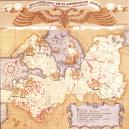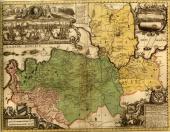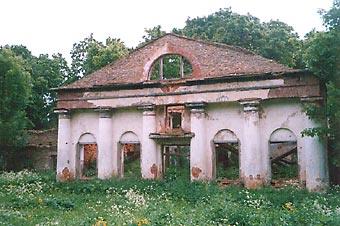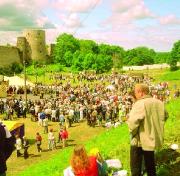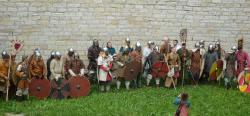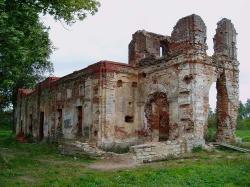Articles
/
Koporye Fortress
Koporye Fortress
Subject /
Architecture/Fortresses and other fortifications
Koporye Fortress (village Koporye, on the bank of the river Koporka) is located on the top of the rock which surrounded by valley of the river and ravines. It is located 12 km from the Gulf of Finland. The fortifiers were attracted the convenient strategic position of the fortress since the XIII century. The Germans were burned the churchyard Koporye and they founded the wooden castle in 1240 which was soon destroyed by the Novgorod army of Alexander Nevsky. The wooden city was erected by The Prince Dmitri (son of Alexander Nevsky) in 1279 and in 1280 he replaced it with stone.In 1282 Dmitry lost the principality of Novgorod, and Novgorod people destroyed the fortifications. Novgorod people in 1297 built the new stone fortress in connection with the danger of invasion of the Swedes, Danes and Germans, and the fortress became the center Vodskaya land. At the end of the 13th century Koporskaya fortress, with its curved walls, is example of a stone fortification of the doognestrelnuy period. After 1361 the walls were overbuilt on 2 m. Kaporskaya fortress was mentioned in chronicles in connection with the fights with the Germans (1338), awards service princes (1333, 1383) and as a refuge Novgorod boyars (1342, 1350). When the fortress Yam (1384) was built the defensive significance Kaporskoy fortress is reduced. In 1520-25 the castle was rebuilt in the light of the increased power of artillery. The Italian fortifiers were led building. They had been dispatched by the Government of Vasiliy III. Builders took into account the peculiarities of the relief. From the south and south-western side, which protected by river valley, the fortress walls of the XIII century have been preserved and made thicker. The northern and eastern walls, with four and five-tiered tower height of 20 m and the pryasla between them were rebuilt. Double-drift winch arrangement with a drawbridge, which flanked by two towers on the eastern side of the fortress, the wall with five-meter at the base and with the shooting loophole on top, with cannon embrasures pechurami, vaulted casemates of the first tier towers were designed to answer fire-attack. At the beginning of XVII century the fortress was captured by the Swedes and before 1703 was a mainstay of Swedish rule on the Finnish Gulf. During the Northern War after the siege of the fortress was captured by Russian troops. To our time is a large gap in the south-west wall which is the result of Russian artillery. Koporie was granted to Menshikov A.D. by Peter I in 1707 in perpetuity. In the XVIII century Koporskaya fortress was lost its military significance. Archaeological excavations were conducted by Ovsyannikov O.V. in 1970-73.The cultural deposits are contain stratums XIII-XV, XV-XVI, XVII-XVIII centuries. Remains framework of houses, objects Novgorod types, as well as jewelry bodi and estonians were discovered in the lower layer. Parts of the walls of the XIII century, the foundations of the Church of the Transfiguration (recreated in 2003), the Commandant's Office of the XVII century were discovered by archaeologists. Since 2002 here is working museum "Koporye fortress".
Authors
Plotkin, Konstantin Moiseyevich
Persons
Alexander Nevsky, Prince
Dmitry Aleksandrovich, Grand Duke
Gustav Adolf II, King of Sweden
Ovsyannikov, Oleg Vladimirovich
Peter I, Emperor
Vasily III Ivanovich, Grand Prince of Moscow
Geography
Topographical landmarks/Gulf of Finland, the
Topographical landmarks/Koporka River, the
Leningrad Oblast, the/Lomonosov District/Koporye Settlement, Railway Station
Historical Toponyms/Vodskaya Land
Bibliography
Овсянников О.В. Копорье: Ист.-краевед. очерк. - Л., 1976 Л., 1976.
Кирпичников А.Н. Каменные крепости Новгородской земли. Л., 1984, С.150-159
Кирпичников А.Н. Овсяников О.В. Древнерусский храм в Копорье // Культура средневековой Руси. Л. 1974., С.139-146
Subject Index
"Koporye Fortress", a museum
The Transfiguration Cathedral (Koporye Village, Lomonosov District)
Vod (Votes)
Mentioned in articles:
|
hidden
|
Archaeological monuments
Archaeological monuments of the Leningrad Oblast are settlements, grads, burial grounds, religious objects and other material trails of the past. Settling the oblast territory took place during the Mesolithic period. The age of the most ancient... more
|
|
|
|
hidden
|
Cemeteries
Cemeteries. The history of cemeteries on the modern Leningrad Oblast territory has not studied practically yet. The reiterated devastation these lands during the wars led to the destruction of many graves and tombstones.... more
|
|
|
|
hidden
|
Ingermanlandia
INGERMANLANDIA (Swed. Ingermanland, Rus. Izhora Land or Ingria), historic and cultural region in the western part of the Leningrad Oblast (Kingisepp, Volosovo, Lomonosov, Vsevolozhsk, Gatchina, Tosno, western part of Kirovsk Districts.) The western... more
|
|
|
|
hidden
|
Koporye, a country estate
Koporye (Grevova), a country estate in the Lomonosov district. In the 18th century Koporye lands belonged to the Count Razumovskys. In 1809 Count Rasumovsky sold the large estate (15000 desyatinas) with 14 villages to the senator V.N. Zinovyev. His... more
|
|
|
|
hidden
|
Koporye, village
KOPORYE, a settlement in Lomonosov District. Population: 1,400. Located at the Koporka River, close to the railway station of the same name of the Kalische-Ust-Luga branch (opened in 1926.) The toponym K. supposedly originates from the verb “kopat”... more
|
|
|
|
hidden
|
Memorials to the Great Patriotic War
Memorials to the Great Patriotic War. The idea of creating memorials on the firing lines of the Leningrad defence appeared in the years of World War II. The first temporary monuments on the line of the Leningrad front were builtin 1944-45 after the... more
|
|
|
|
hidden
|
Military-historical celebrations and events
MILITARY AND HISTORICAL FESTIVITIES AND ACTIVITIES. The Russian Federation federal law “O Dnyakh Voinskoy Slavy (Pobednykh Dnyakh ) Rossiy” (“About Days of Military Glory (Victory Days ) of Russia”) was issued in 1995. The oblast programme,... more
|
|
|
|
hidden
|
The Transfiguration Cathedral (Koporye Village, Lomonosov District)
The Transfiguration Cathedral (Koporye Village, the Lomonosov District). The original stone cathedral with the side-chapel of the Intercession of the Holy Virgin was built in the Koporye Fortress in the second half of the 14th century. The... more
|
|
|
|









